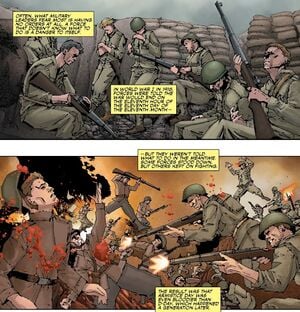World War I: Difference between revisions
From Halopedia, the Halo wiki
BaconShelf (talk | contribs) m (i don't think this is really a necessary note) |
(Reworded slightly) |
||
| Line 30: | Line 30: | ||
==War== | ==War== | ||
World War I was the first human conflict | World War I was the first human conflict in which flamethrowers were used. Trench warfare was common during the war.<ref name="flamethrower">''[[Halo Wars: Official Strategy Guide]]'', Factions: UNSC, p. 40</ref> | ||
===War's end=== | ===War's end=== | ||
By [[1918]], forces were told that the war would end on November 11. However no orders were given about what would happen prior to that. This resulted in some forces standing down and others | By [[1918]], forces were told that the war would end on November 11. However, no orders were given about what would happen prior to that. This resulted in some forces standing down and others continuing to fight. On Armistice Day itself, the fighting was more intense than [[Wikipedia:D-Day|D-Day]].<ref name="undefeated"/> | ||
==Aftermath== | ==Aftermath== | ||
Revision as of 11:05, January 23, 2021
| There is more information available on this subject at World War I on the English Wikipedia. |
|
Previous: |
|
|
Next: |
|
| World War I | |
|---|---|

| |
|
Date: |
??-Armistice Day: November 11, 1918[1] |
|
Location: |
|
|
| |
World War I was a Human conflict.[1]
War
World War I was the first human conflict in which flamethrowers were used. Trench warfare was common during the war.[2]
War's end
By 1918, forces were told that the war would end on November 11. However, no orders were given about what would happen prior to that. This resulted in some forces standing down and others continuing to fight. On Armistice Day itself, the fighting was more intense than D-Day.[1]
Aftermath
Following the conflict, flamethrowers changed very little over the centuries.[2]
List of appearances
- Halo: Tales from Slipspace
- Undefeated (First appearance)
Sources
- ^ a b c Halo: Tales from Slipspace, Undefeated
- ^ a b Halo Wars: Official Strategy Guide, Factions: UNSC, p. 40
| |||||